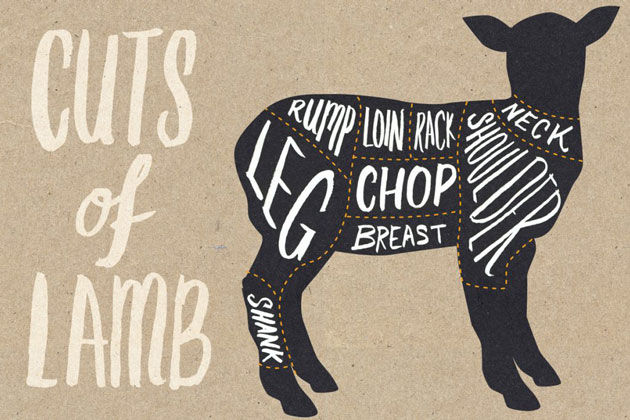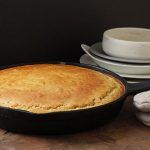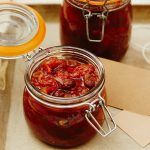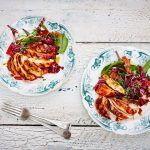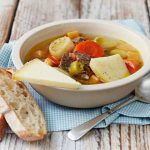We’ve pulled together this guide to help you understand more about the different cuts of lamb available and what cooking method each cut is best suited to.
Before you decide on which lamb cuts you’re going to buy, remember to always buy free-range or organic whenever possible. This means the animal has led a happy and healthy life, often born and reared outdoors in small numbers where it can forage and exercise as nature intended. If you’re looking to trade up, look for higher-welfare certifications, such as RSPCA Approved or Certified Humane as a minimum. Lamb is a great source of protein, vitamins and minerals, but just be sure to choose leaner cuts on most occasions, reserving the fattier pieces for weekend treats.
This is our guide to choosing the best cut of lamb for your dish of choice.

- SHOULDER
This part of the animal works hard, so the meat from a lamb’s shoulder is full of flavour. It takes a while to become tender, but this means it’s a great choice for stewing and slow-roasting. To maximise the flavour, cook lamb shoulder on the bone so the meat simply falls apart when pulled with a fork. Recipes using lamb shoulder are fail-safe crowd pleasers – try this slow-cooked shoulder with roasted vegetables for a perfect Sunday lunch or roast in fragrant spices for a more feisty dish. To keep things super simple, make a herb rub with some mint or rosemary, garlic, sea salt, black pepper and olive oil, slash the skin of the meat and massage the rub into all its nooks and crannies. Sit it on top of wedges of onion, add some liquid, cook on a high temperature to get the skin lovely and golden, then cover and turn down to low (around 160ºC) for 4 to 5 hours (depending on the weight of the shoulder). - CHOP/RACK
Lamb chops or cutlets are the most expensive cuts of lamb, but are incredibly delicious and tender. They are taken from the ribs of the lamb and cooked individually, normally over a grill or a barbecue. When a number of them are left together and cooked as a whole, they’re called a rack of lamb. Chops and racks can be French trimmed, where the meat is scraped from the ends of the rib bones, which looks super-impressive on a plate. Best served pink, they are amazing roasted and served with crushed potatoes or served lollipop style – perfect for sharing. - LOIN CHOP
These are mini T-bone steaks cut from the waist of the lamb. On one side of the chop is the lamb loin and on the other side is the fillet. Just like chops, they’re great for grilling or barbecuing – serve with a fattoush salad for a Middle Eastern vibe or marinate in paprika and mint and serve with harissa-spiked houmous to embrace delicious Moroccan flavours. A few loin chops kept together in one piece, then boned and rolled, make a lovely little roasting joint. - RUMP
The rump comes from the back of the lamb. This cut is lean, tender and full of flavour – just be careful not to overcook as it will become tough if left to dry out. It is delicious pan-fried whole, finished in the oven for a few minutes, then sliced to reveal its blushing pink centre. Or, it can be cut into chops on the bone then grilled or pan-fried. - LEG
Like the shoulders, the legs of a lamb work hard, which means that this cut has a good, strong flavour. Leg of lamb is great roasted whole on the bone, or boned and barbecued. It’s a fairly lean muscle, so take care not to overcook it, or else it could end up quite dry. Rub it all over with a herb oil, some garlic and even a little mustard, if you like, roast in the oven, then finish off on the barbecue to get a great gnarly smoked flavour. This is a great one for a weekend spent with family, or when entertaining a big group – try Jamie’s ultimate roast leg of lamb with homemade mint sauce or roast, then team up with some fresh seasonal spring veg.To learn how to bone and butterfly a leg of lamb, watch Jamie’s Food Team: - SHANK
Lamb shank is a super-simple, cheaper cut that goes a long way. Taken from the lower part of the back legs, there is a lot of collagen in the shank, which, when cooked slowly, gives the meat a lovely soft, melting texture, making this another cut that’s perfect for stews and slow-cooking. Keep things British and cook with a stout or porter to add real depth, or go Moroccan with a mouth-watering tagine. - NECK
Neck is a cheap cut and available at supermarkets and butchers. It is left connected to the shoulder, but a good butcher should be willing to separate it out for you. Lamb neck can be cooked slowly on a low heat, yet unlike the shoulder, it can also be treated like a steak and cooked quickly over a high heat until pink. It goes well with a whole load of flavours and is delicious served with a great mash when cooked low and slow. It works really well as a stew or curry and is a great cut of meat to make kebabs with, too.
If you want to make a delicious lamb marinade, try this beautifully fragrant recipe from Jamie, perfect for shoulder and leg cuts:
Check out Jamie’s handy guide to roasting meat for timings and extra tips for cooking the perfect lamb.
